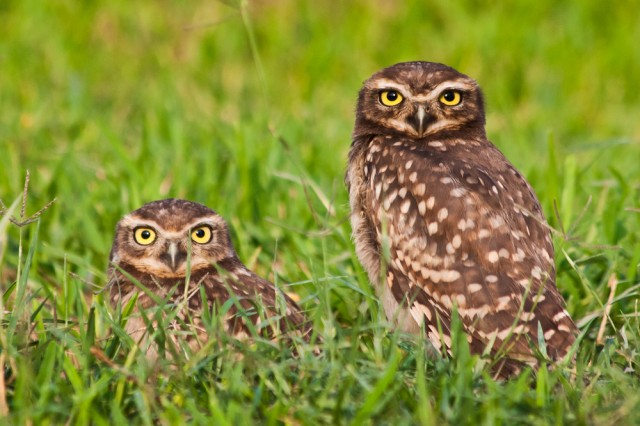Burrowing Owls
Status
Burrowing owl (Athene cunicularia) is designated a “California Species of Special Concern” by the California Department of Fish and Game. It is considered a rare to very uncommon breeder or yearlong resident, and rare migrant and winter visitor of dry grassland and desert habitats throughout California. This species was formerly common in suitable habitats throughout the state, but numbers have declined substantially due to disturbance or loss of habitat, and extermination of burrowing mammals.
Description
Burrowing owl is a smaller-sized owl with long legs, a rounded head with no ear tufts, a yellow bill, and short wings. Adults have white spotting on the breast and dark barring on the belly. The brown upperparts are flecked with white. Immature owls are similar in appearance but their dark breast and light belly is unmarked. Adults range in size from 8 to 9 inches in length and have a wingspan of approximately 20 to 24 inches. The average adult burrowing owl is slightly larger than an American robin.
Habitat Requirements
Burrowing owls occur in dry grasslands, deserts, agricultural areas, and rangeland with sparse and low-growing vegetation. They also use man-made structures such as debris piles, culverts, and cement piles for cover where burrows are scarce. The burrowing owl is the only owl in North America that nests in underground burrows. It does not excavate its own burrow but rather uses abandoned burrows of rodents such as ground squirrels. Sign of burrowing owl occurrence within an area may include the presence of molted feathers, cast pellets, prey remains, or excrement near a burrow entrance.
Breeding of burrowing owl occurs from March to late August, with peak nesting activity occurring in April and May. Usually 5 to 6 eggs are laid and incubation occurs for 28 to 30 days. The young generally emerge from the burrow at 2 weeks and fly at 4 weeks. Until reaching independence at 44 days, the young burrowing owls remain near the burrow and join the adults to forage at dusk.
Burrowing owls hunt day or night and frequently perch or stand at burrow entrances during the daytime. This species pounces from a mound, swoops down from flight, or hops along the ground after prey. The diet of burrowing owls consists mainly of ground insects, such as grasshoppers and beetles, but sometimes includes small mammals, reptiles, small birds, and carrion. Natural predators of this species include red-tailed hawks, Swainson’s hawks, prairie falcons, northern harriers, golden eagles, foxes, coyotes, and domestic dogs and cats.
Local Occurrence
Burrowing owls occur at the Orchard Creek Conservation Bank, Valley Glenn, Pope Ranch, and Haera Ranch preserves.

 (916) 434-2759
(916) 434-2759



